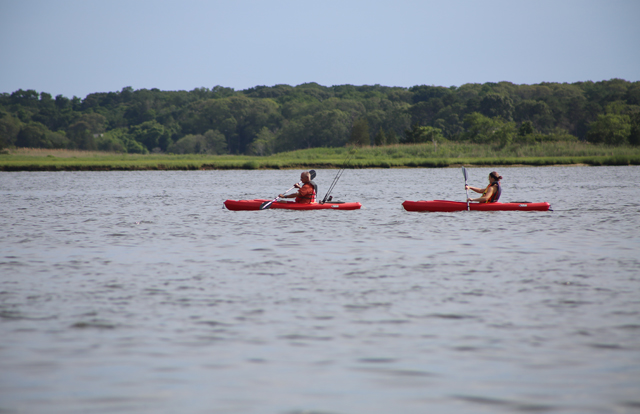Posted on November 17, 2020
To help protect the 250 square miles that comprise the Peconic watershed, the Peconic Estuary Partnership recently unveiled its 2020 Comprehensive Conservation and Management plan, which will serve as its roadmap for the next decade.
The 88-page document identifies clean water, abundant wildlife habitats, a thriving coastal economy and climate change preparedness as top goals and outlines a series of 35 objectives to aid in its implementation.
According to PEP executive director Joyce Novak, the plan was last updated in 2001 and was initially developed in response to the prevalence of brown tides that degraded water quality in the 1980s and 1990s.
While the 2001 plan honed in on the brown tides, Ms. Novak said Monday that the 2020 plan now acknowledges numerous kinds of harmful algal blooms that have been well-documented in the estuary in the years since.
“Now, we have a great understanding about harmful algal blooms and we know how to get to the root of the problem,” she said, pointing to nitrogen-reducing initiatives like the advancement of alternative septic systems.
Over two decades, Ms. Novak said, there has been a massive shift in understanding climate change, a key issue addressed in the 2020 management plan.
“It’s not ‘Is climate change real?’ anymore,” she said. “This is it. It’s here now.”
The plan’s release coincides with the start of what many have proclaimed to be the start of another dismal bay scallop season.
“We’re facing another tragedy this year,” Ms. Novak said, noting that some baymen have already remarked that this is worse than last year’s catastrophic scallop die-off.
In addition to the presence of the parasite responsible for last year’s loss, Ms. Novak said there are other environmental factors at play, including consistently warmer water; more dissolved oxygen, which acts as a “proxy” for nitrogen input; and, in 2020, the observation of cownose rays in local waterways. Ms. Novak called for more research into the rays, which are traditionally found in warmer waters.
She said the plan would address a plethora of concerns that could be contributing to the scallop decline and other environmental issues and hopefully reverse them.
Specifically, the plan calls for multi-agency partnerships, resilient communities, clean water and a healthy ecosystem in order to meet challenges posed by climate change, development and pollution.
Though rising sea level from climate change remains a top threat to the estuary, other repercussions of climate change — more frequent and intense storms, rising water temperature and changing weather patterns — will also be felt in the bay.
Other challenges outlined in the document include water quality, the degradation of habitats due to development and hardened shorelines, nitrogen pollution and harmful algal blooms.
“This guiding document will be critical to policy and lawmakers moving forward as we confront the many challenges and threats facing the Peconic Estuary system, and give us opportunities to improve water quality,” Suffolk County Legislator Al Krupski (D-Cutchogue) said in a statement.
The plan cited reports that show 12 sewage treatment plants discharging wastewater into the bays and estimates that 35,000 on-site sanitary systems are also contributing to nitrogen loading throughout the watershed area.
Eelgrass acreage has also declined from approximately 8,700 acres in the 1930s to just 1,000 acres in 2013, according to the report. Shoreline hardening projects, including bulkheads, have more than doubled in the last 20 years.
Among the mitigation efforts included in the plan are a proposal to form partnerships and bolster community engagement through awareness and outreach, as well as creating more citizen science programs to foster change. Additional support for bilingual programming and materials was also outlined as a goal, as part of an effort to reach the entire East End community.
Partners listed in the 88-page plan include local, county, state and federal government entities, the Shinnecock Indian Nation, local businesses, residents, nongovernmental organizations and academic institutions.
“We made a conscious decision when we changed our name from the Peconic Estuary Program to Partnership to really connect more with communities and people,” Ms. Novak said. “We’re heavy on [working with] the county, state and municipalities but our heart is the East End. The communities are passionate and care about their waterways and that’s what we’d like to have as a driver over the next decade.”
Aside from engaging the communities surrounding the estuary, the organization hopes to implement a “State of the Peconic Estuary” reporting process to monitor water quality, conduct additional research into algal blooms and toxins and quantify the impacts of fishing, boating, dredging, hardened shoreline structures and other uses on the habitats of vulnerable species.
Initiatives such as living shorelines and restoring fish spawning habitats and eelgrass will also play instrumental roles as the organization looks to double down on its efforts to fight climate change.
In a statement, state Department of Environmental Conservation commissioner Basil Seggos noted that the estuary provides feeding, spawning and nursery grounds for hundreds of species.
“As New York continues to combat the effects of climate change, the updated Comprehensive Conservation Management Plan will further ensure the protection of species that rely on this habitat, improve coastal resiliency and safeguard water quality in concert with the Long Island Nitrogen Action Plan,” Mr. Seggos said.
Suffolk County Executive Steve Bellone said the plan will complement the county’s Reclaim Our Water initiative, which seeks to address water quality issues that stem from cesspools and septic systems.
Established in 1992 under the U.S. Environmental Protection Agency’s National Estuary Program as an “Estuary of National Significance,” the Peconic Estuary Partnership is a collaboration among the state, county, scientific community and residents to address issues within the Peconic Estuary Watershed.
The plan can be viewed in full at peconicestuary.org/ccmp2020.
Source: riverheadnewsreview






